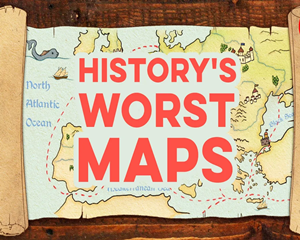(单词翻译:单击)
On a tiny copper globe created in the early 1500s, the coast of Southeast Asia is marked with a message that has since become iconic: Here be dragons.
在16世纪初制作的小型铜制地球仪上,东南亚的海岸线上被标上了后来成为标志性的一条信息:巨龙出没。
Though the words themselves were actually quite rare, the sentiment was common among medieval European mapmakers,
虽然这些字本身并不多见,但这种情结在中世纪的欧洲地图绘制者中是常见的。
who often scrawled dragons and sea monsters over terra incognita -- blank spots on the map.
他们经常在地图空白的未知土地上涂鸦龙和海怪。
For thousands of years, people all over the world had made both functional maps
数千年来,世界各地的人们制作出了实用性的地图,
showing trade routes, settlements, topography, water sources, the shapes of coastlines, or written directions
显示贸易路线、定居点、地貌、水源、海岸线的形状和书面指示,
and what are known as cosmographies, illustrating the Earth and its position in the cosmos, often including constellations, gods, and mythic locations.
以及所谓的宇宙图,显示地球和它在宇宙中的位置,通常包括星座、神灵和神话中的地点。
From the Middle Ages through the mid-17th century, cartographers in Eurasia and North Africa produced a slew of new world maps with features from both these traditions.
从中古世纪到17世纪中期,欧亚和北非的制图者们制作了大量具有这两种传统特征的新世界地图。
Often commissioned by rulers and other powerful people, these maps were meant to depict the world's geography, but not necessarily to be useful for navigation.
制图者通常是受统治者或者其他有权利的人委托的,这些地图是为了描绘世界地理,对航行不一定有帮助。
And given their maker's incomplete knowledge of the world, they were really hypotheses -- some of which have been glaringly disproven.
由于制图者对世界不完整的认知,绘制的地图其实是假设性的,其中的一些地图已经被明显地否定了。
In medieval Europe, the new vogue began with what were known as mappae mundi.
在中世纪的欧洲,新的时尚始于赫里福德世界地图。
Many of these veered closer to cosmographies, featuring the Garden of Eden or mythical dragons.
许多的这类地图更接近于宇宙图,以伊甸园或神话中的龙为主题。
They all followed the same format, showing the world's land as one mass divided roughly into the shape of a T and surrounded by a ring of ocean.
它们都遵循了同样的格式,将世界陆地作为一个整体,大致分为T字形,被一圈海洋包围。
Islamic mapmakers also created world maps in this format, emphasizing geographic details over fantastical elements.
伊斯兰地图绘制者也制作了同样格式的世界地图,强调了地理细节而非幻想元素。
One of the earliest and most accurate such maps was created by Ibn Hawqal, whose own travels informed his mapmaking.
伊本·哈克尔是最早和准确制作出这种地图的人之一,他的出行为他的地图制作提供了素材。
In 1154, the King of Sicily commissioned Islamic mapmaker Al-Idrisi to create the "Tabula Rogeriana," also known as "A Guide to Pleasant Journeys into Faraway Lands."
在1154年,西西里岛国王委托了伊斯兰地图绘制者伊德里西去绘制《鲁杰罗之书》,又称《渴望周游世界者的娱乐》。
This book of maps included a world map based on Idrisi's own travel and interviews with other traders and travelers.
这本书包括了基于伊德里西自己出行的世界地图,还有与其他贸易商和旅行者的对话。

He correctly depicted the world as a flattened sphere, but thought Europe, Asia, and North Africa wrapped all the way around it.
他正确地将世界描绘成一个扁平的球体,但认为欧洲、亚洲和北非一直包裹着它。
The "Da Ming Hunyi Tu" was created in China in 1389 on a piece of silk big enough to fill an entire room.
《大明混一图》制作于1389年的中国,在一片足够填满整个房间的丝绸上。
Though the mapmakers had never been to Africa, they attempted to depict the continent based on the accounts of the traders who'd been there.
虽然地图绘制者没有去过非洲,但他们尝试根据去过那里的贸易商的叙述来绘制出非洲大陆。
Surprisingly, this gave them enough information to create a correctly shaped portrayal of sub-Saharan Africa.
令人惊喜的是,这提供了足够多信息去绘制正确的撒哈拉以南非洲的地形。
Beginning in the 15th century, European cartographers began to expand the scope of their world maps as their explorers traveled the world -- but not without missteps.
16世纪的早期,在欧洲探险家走遍世界的同时,欧洲的制图者开始扩展他们世界地图的范围。不过,并非没有失误。
In 1507, the German cartographer Martin Waldseemuller mapped the Americas -- as a thin sliver of land where the east coast would be.
在1507年,德国制图者马丁·瓦尔德塞穆勒绘制美洲为东海岸的一片薄薄的土地。
Spanish cartographers took a stab at the western side of the Americas based on accounts from an expedition to the Baja Peninsula.
根据一次远征巴哈半岛的记录,西班牙制图者尝试绘制出美洲的西侧。
Unfortunately, the explorers' impressions of the land led them astray:
不幸的是,探险家对这片土地的印象使他们误入歧途,
for over 100 years after, Spanish maps depicted the "Island of California" detached from the rest of the continent.
之后的100多年里,西班牙地图描绘了与大陆的其他部分分离的“加利福尼亚岛”。
The Flemish cartographer Gerardus Mercator, best known for his world map, also created a map of the never-before-seen North Pole that was published in 1595.
佛兰德制图师杰拉德·墨卡托以绘制世界地图而闻名,同时绘制了一幅从未见过的北极地图,并于1595年出版。
Mercator speculated that the North Pole prominently featured the "Rupes Nigra,"
墨卡托推测北极的显着特征是“黑卢比”,
a giant magnetic rock surrounded by a whirlpool that explained why all compasses point north.
一块被漩涡所包围的巨大磁岩,解释了为什么所有的指南针都指向北方。
Even as Europeans built towards a complete picture of the Earth, they didn't entirely let go of the idea of blank spots filled with mythic beasts.
在欧洲人建立一个对地球的完整认识的时候,他们并没有完全放弃用神话中的野兽填补空白的想法。
As late as 1657, English scholar Peter Heylin lumped Australia together with Utopia and Fairyland.
晚至1657年,英国学者彼得·海林将澳大利亚与乌托邦和仙境混为一谈。
But with the exception of the North Pole, these so-called terra incognita weren't really unknown -- at least not to the people who lived there.
除了北极地区之外,这些没有被发现的土地并不是未知的,至少对住在那里的人们来说。
There weren't really dragons anywhere on Earth,
地球上并没有这些神话中的野兽,
but there were people and cultures -- many of them eradicated by those who put their lands on world maps.
但有的是原住民和文化,大部分被绘制地图的人刪除了。


